

Damion Smy
Ford Everest Tremor gets 260kW V6 ‘Ranger Raptor’ treatment
11 Hours Ago
We take the seven-seat LandCruiser 300 Sahara on an interstate road trip to see if it's still the 'King of the Road'.



Quickly see how this car stacks up against its competition. Select any benchmark to see more details.
Where expert car reviews meet expert car buying – CarExpert gives you trusted advice, personalised service and real savings on your next new car.
Australians love the Toyota LandCruiser. It doesn’t matter which corner of our vast land you’re from, you probably know someone that’s owned a LandCruiser, or owned one yourself.
Whether it’s the iconic 70 Series, the more city-friendly Prado, or the full-sized 100 Series or 200 Series, the nameplate resonates with adventurous families who want rugged go-anywhere capability, bulletproof reliability, as well as the comfort and luxury necessary for an Aussie road trip.
Geez, does the new 2022 Toyota LandCruiser 300 Sahara have big shoes to fill.

The Sahara specification of the full-size LandCruiser has been a popular one for yonks, so the vehicle you see here is arguably the most important version of Toyota’s new-generation luxury off-roader.
At a little over $130,000 before on-roads, it certainly isn’t cheap but it packs a lot of stuff for your spend. As we’ve seen in previous reviews, it should be able to handle every dirt trail, rocky climb, and family holiday you can throw at it.
Given we’ve now sampled several LC300 variants, I wanted to do something a little different. So I drove the big ‘Cruiser to Adelaide and back over the Labour Day long weekend to see if it’s still the king.
The LandCruiser 300 Sahara is listed from $131,190 before on-road costs, which is around $7000 more than the equivalent LandCruiser 200 Sahara.
Using Toyota’s online configurator and a Melbourne (3000) postcode, the LC300 Sahara will total about $143,900 drive-away with standard paint. Premium exterior finishes cost $675 extra, including our tester’s Graphite metallic.
2022 Toyota LandCruiser 300 pricing:
All prices exclude on-road costs

Determining rivals for the LC300 is difficult given its size, pricing and capabilities, but we have narrowed it down to a few alternatives offering a similar level of off-road ability, towing capability as well as luxury.
Note there’s a variety of potential rivals listed below in terms of seating capacity, pricing, and drivetrain format.
Key rivals include:
All prices exclude on-road costs



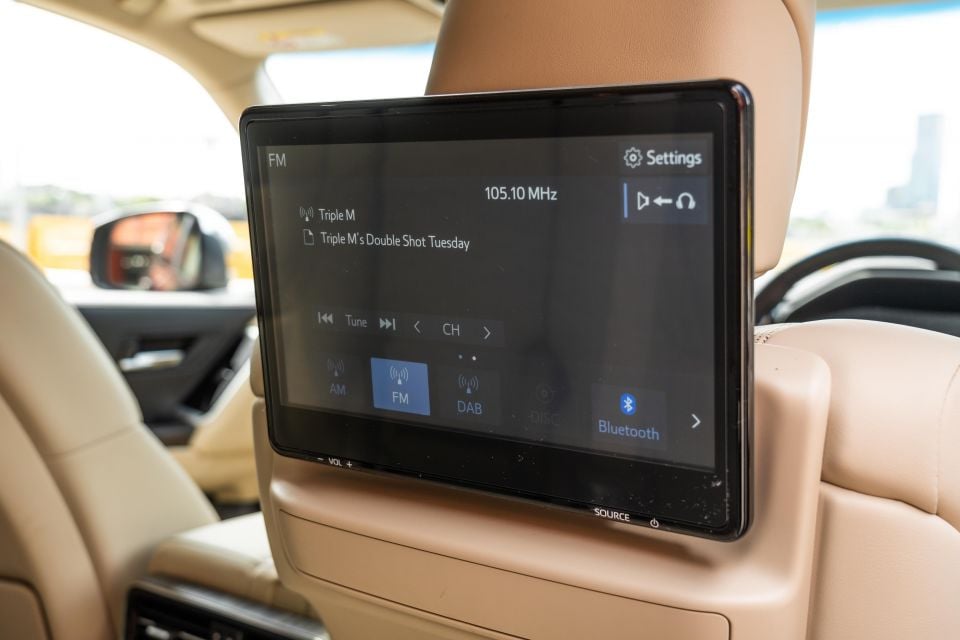
Buy your new car without the stress. It's fast, simple and completely free.

Great service from Travis and team, second time I have used this business would not hesitate to recommend them to anyone
Craig C.
Purchased a Ford Ranger in Sunshine Coast, QLD
CarExpert helped Craig save thousands on his Ford Ranger, now let us save you on your next new car.
Find a dealLandCruiser 300 Sahara highlights:




That’s on top of features shared with lower grades:

The LandCruiser 300 Series wears a five-star ANCAP safety rating with 2022 datestamp.
Category scores included 89 per cent for adult occupant protection, 88 per cent for child occupant protection, 81 per cent for vulnerable road user detection and 77 per cent for safety assist. These scores are based on the latest, strictest ANCAP/Euro NCAP crash-testing criteria.
ANCAP praised the LC300 for performing well across all areas of assessment, particularly with regards to vulnerable road user detection for such a large, high-riding vehicle.
While the 300 Series lacks a front-centre airbag which is becoming commonplace in the industry, ANCAP determined the LC300 provided ‘Good’ protection and prevention of excursion in far side impact tests, and full points were awarded.
The five-star rating applies to all versions of the Toyota LandCruiser 300 with the exception of the GR Sport, which was not assessed and therefore remains unrated.

Standard safety features across the range include:
LandCruiser 300 GXL adds:
LandCruiser 300 VX adds:
LandCruiser 300 GR Sport and Sahara ZX add:

Rather plush, in an old-school LandCruiser kind of way.
Toyota has stayed true to the LC300’s ancestors and kept the up-spec version of its rugged off-roader utilitarian in vibe, but with a smattering of luxury appointments to make this a comfortable place to spend time.
Up front there’s electrically-adjustable chairs and a powered steering column, with memory presets as well as heating/ventilation both in the front and in the second row.
The fake woodgrain isn’t super convincing but suits the colour scheme and ambience, especially since our test car had the beige interior specified – stain-friendly black is also offered.
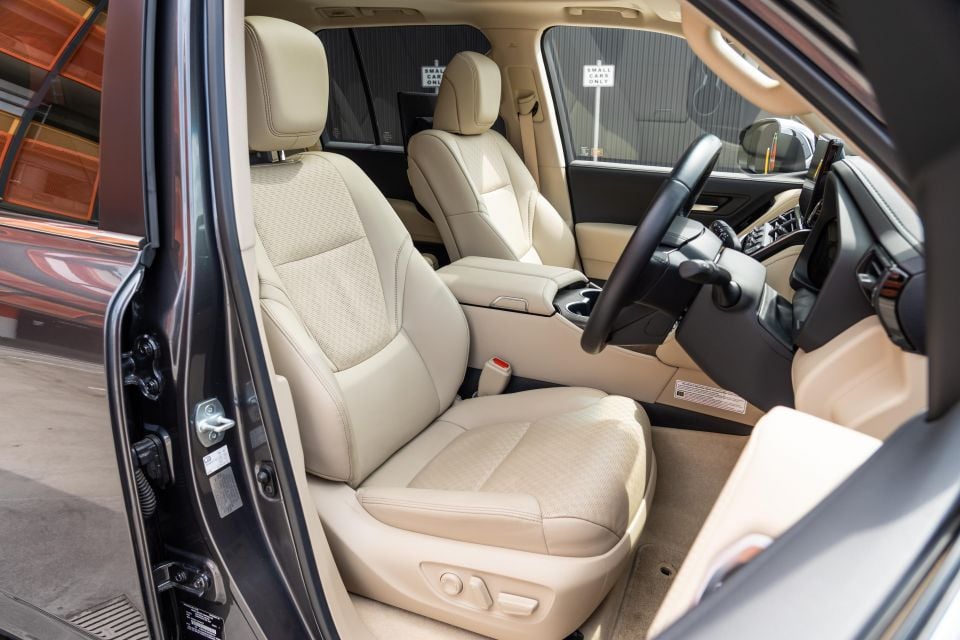

Soft-touch materials adorn all surfaces you touch or rest on, including the padded knee rests on either side of the centre console. The silver trim accents in places feel like metal which is a nice touch, too.
The LandCruiser’s new 12.3-inch touchscreen infotainment looks nice on first glance, but then you realise it’s running the basic interface used in the wider range and there’s an annoying sidebar that’s always displayed so you can’t make full use of the display.
It’s well featured and everything generally works well, but it can be slow to react at times and lacks the look and feel of more sophisticated systems from European alternatives. The Lexus LX will have a stacked dual-screen layout that no doubt will be a development of the system you see here.
That said, it’s light years ahead of the ancient head unit in the Nissan Patrol.


Over the GX, GXL and VX the Sahara gains a 14-speaker JBL premium audio system, which is pretty good at high volume. Sound is clear and bass is deep, which almost turns the LC300 into a rolling nightclub.
Storage up front is less impressive. The Qi charging pad can’t fit my iPhone 13 Pro Max when hardwired to Apple CarPlay, the door bins are on the smaller side, and the cooler box under the front-centre armrest isn’t as capacious as it looks – though it still fit a decent amount of road trip drinks and snacks.
There are two pretty large cupholders up front too, one with an adjustable floor to accommodate taller cups and bottles, but that’s about it.
It’s a shame there’s not a larger cubby under the centre stack up front, but there is a deep glovebox to hide things away.




The second row is something of a mixed bag. While it’s fully featured to almost luxury limousine levels on paper, the interior packaging means this hulking upper large 4×4 doesn’t have the biggest back seat.
Sitting behind a tall driver (6’1) like myself, a taller passenger may be a little tight for knee and toe room. Headroom is excellent thanks to the boxy proportions and tall roofline, however.
A third person sitting in the centre seat has to deal with a wide and pronounced driveline hump in the floor, which makes this LC300 a better 2+2+2 seater than a 2+3+2 – more on the rearmost seats in a bit.
The rear accommodation may not be as palatial as the LandCruiser’s exterior dimensions might have you expect, but I managed to pack three adult friends in the second row on multiple occasions with no complaints – other than arguing about who had control over the playlist… the trauma.
We appreciate the large rear entertainment screens, though their functionality is fairly limited unless you plug a device in or insert a DVD, as well as two extra zones of climate control, roof-mounted and knee-level vents, airline-style hard-backed map pocket and finally heated/ventilated outboard rear seats.
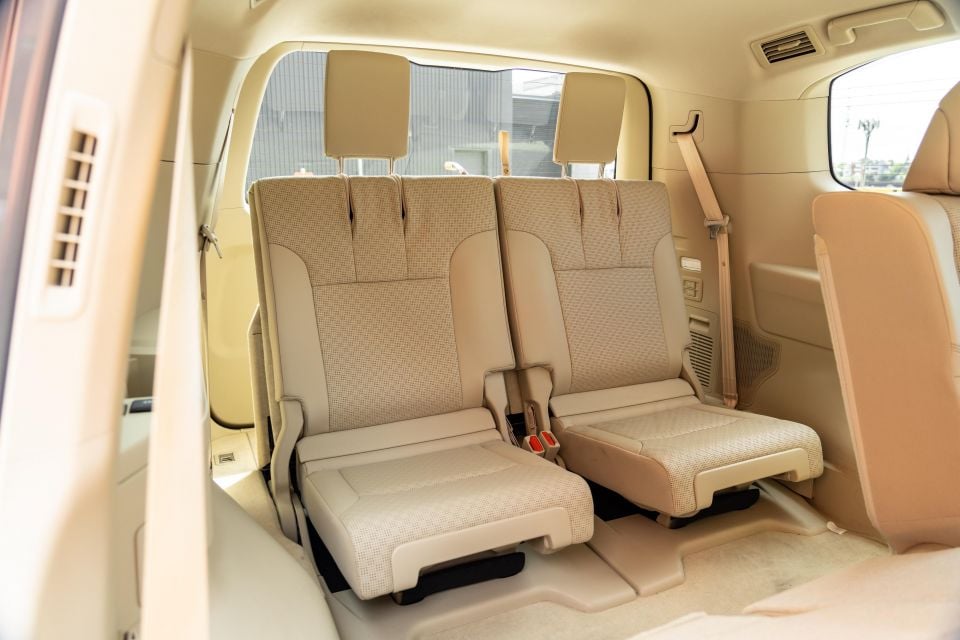



Further back again you have an additional two seats that in the Sahara are operated via switches in the booth area.
Compared to previous generations of LandCruiser, the LC300’s third row has enough elevation over the high boot floor that kids and smaller adults can sit in there without having their knees pushed into their cheeks, and I had two friends sit fairly comfortably back there for a two-hour – though they did note any longer and there may have been complaints.
Cupholders and air vents feature in the rear, as do remote releases for the second-row seats and USB charging points on both sides to keep mobile devices juiced.
What’s not so flash is what is (or isn’t) behind the third row. In seven-seat configuration the LandCruiser 300 only quotes 175L (VDA) measured to the roofline, which is barely enough for a couple of skinny bags. Drop the third row (which folds neatly into the floor) and the volume expands to a much more accommodating 1004L (VDA) to the roofline, and then 1967L (VDA) with both the second and third rows folded.
All LandCruiser 300 models feature a full-size spare wheel mounted under the rear of the vehicle.

All versions of the LandCruiser 300 Series in Australia are powered by a new 3.3-litre V6 twin-turbo diesel generating 227kW (4000rpm) and a meaty 700Nm (1600-2600rpm).
Drive is sent to a full-time 4×4 system via a 10-speed automatic transmission with low-range and a locking centre differential. There’s also several drive and off-road terrain modes to adapt to the conditions, as well as assists like crawl control, downhill assist control, and hill start assist control to make 4×4-ing that much easier.
Overseas, there’s also the choice of a new 305kW/650Nm 3.5-litre twin-turbo petrol V6 shared with the related Lexus LX600. It’s unclear whether Toyota will eventually bring the LC300 petrol to Australia.

Where expert car reviews meet expert car buying – CarExpert gives you trusted advice, personalised service and real savings on your next new car.
Although it’s down 1200cc and two cylinders on the outgoing LandCruiser 200’s V8 twin-turbo diesel, the new V6 has 27kW and 50Nm more.
It’s also more efficient according to laboratory testing, quoting combined fuel consumption of 8.9L/100km – a 6.9 per cent reduction on the V8’s 9.5L/100km claim.
Toyota quotes a 110L fuel capacity for the LandCruiser 300 line-up, encompassing an 80L main tank and a 30L sub-tank. With our real-world indicated figure of 10.0L/100km, you can achieve over 1000km between fills.

I spent a week with the LandCruiser doing my usual daily commuting plus some trips out to the Melbourne 4×4 Proving Ground in Mt Cottrell in Melbourne’s outer west to help out with a big upcoming project – more to come soon.
Obviously the LandCruiser 300 is designed to be eating up country highways and scaling rocky climbs, but it’s actually not too out of place in the confines of the city.
While the physical dimensions are daunting, the 300 Series has light and user-friendly controls backed by a suite of assistance systems to make piloting this leviathan that much easier in places like Melbourne’s CBD.
Light steering, effortless acceleration, and helpful features like blind-spot monitoring make the LC300 quite agreeable in peak-hour commuting, though you can’t escape its sheer size. Occasionally you’ll be whipping your eyes left to right to make sure you’re not drifting over lane markings.

It’s a comfortable and refined place to be, with very little road, engine and wind noise entering the cabin regardless of speed or road surface. The ride is surprisingly good too, with the chubby 265/65 tyres and 18-inch wheels combining with the double-wishbone front and four-link rigid rear axle setup combining to isolate the cabin from the worst Australian roads regardless of whether you’re driving one-up or with seven passengers – even without the adaptive dampers of Sahara ZX and GR Sport models.
Speaking of fully-loading the ‘Cruiser, with all seven seats occupied during multiple runs in and around Adelaide the 3.3-litre twin-turbo V6 diesel easily got up to speed both in town and on the highway. It gave me full confidence that if you had to overtake while fully loaded on a 110km/h interstate highway, you’d have no issues.
The drive between Melbourne and Adelaide (and then back) is a 720km trek each way covering a number of different road types and surfaces. It didn’t matter what road and what weather, the LC300 just ate it all up. Toyota spoke at length during the LC300 launch about the extra work that had been done to make the latest ‘Cruiser more capable at open-road touring, and it’s certainly made great inroads in long-distance refinement and comfort.
Particularly on my way back to Melbourne, which was completed in the late hours of Labour Day Monday with episodes of heavy rain and low visibility, the stability, grip, refinement and performance on offer gave me the confidence to keep going (as safely as possible, of course). The heavy splashes of water from oncoming trucks particularly was dealt with surprising finesse – definitely wouldn’t have been as confident in my Golf.
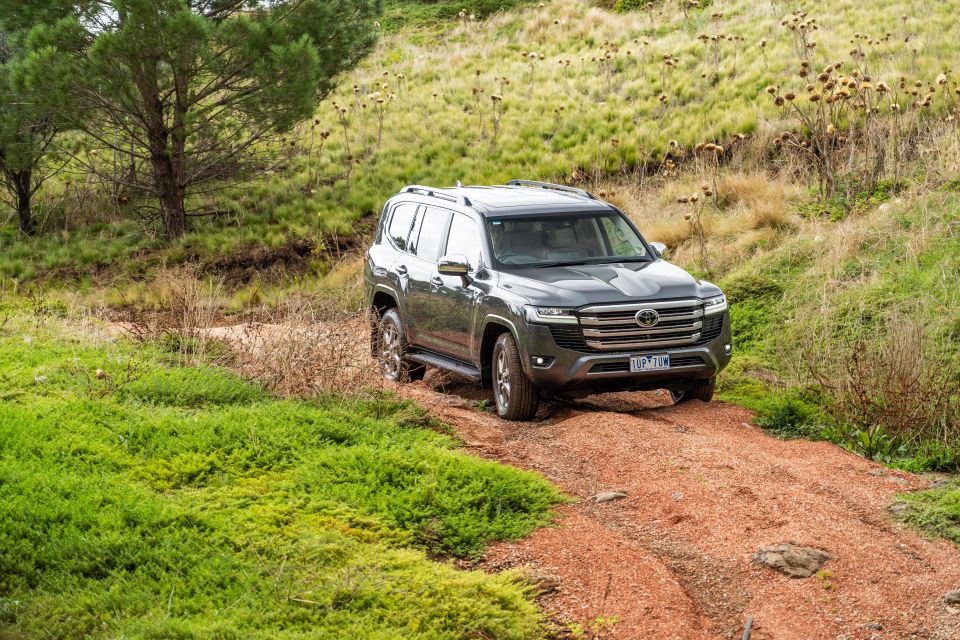
The LED headlights with auto high-beam offer good night-time visibility and the high-beam illuminates a good amount of oncoming environment, but I can’t help but think the matrix-like adaptive high-beam setup from the GR Sport and Sahara ZX should be more widely available given the seven-seat Sahara is already a $130,000 car.
Outward visibility is very good thanks to huge windows and big mirrors, aided by the blind-spot monitoring and rear cross-traffic alert. Adaptive cruise with stop/go also takes the load off during extended freeway stints, especially when you have high-traffic single-lane sections where some motorists are going 10km/h under the speed limit. It saves you constantly turning cruise control off and on.
If I was to make a complaint, it would be centred around the lane-keep assist and Lane Trace Assist systems.
Smaller TNGA-based models with electric power steering seem to get this function right, accurately keeping you between the white lines and never getting overzealous like systems of old. However, the LandCruiser’s size and electronically-actuated hydraulic power steering don’t work as well as perhaps the Japanese brand intended.

The limited space between the LC300’s sides and the white lines due to its width (1980mm) means the steering wheel is constantly vibrating and tugging every time it thinks you’re about to drift out of the lane. Further, the fact it steers back into the lane via braking means it can veer away from a road edge quite violently, so if you haven’t experienced it before or aren’t expecting it to intervene it can be quite alarming.
Further, the Lane Trace Assist works fine on straights or light bends, but cuts power as soon as it has to steer past a certain point meaning you can drop 10km/h in an overtaking lane, which can be frustrating to the point you just turn it off. This system needs some refining to catch up to what’s on offer from the Europeans.
On the topic of cornering, the LC300 does an admirable job keeping its tall, boxy body in check through winding roads, though as you’d expect this 2630kg bus is as far from sporty.
With that said, accurate controls and adequate body control mean you can steer with confidence, though the tyres will let you know quickly when they’ve reached their limits. There were plenty of roundabouts that got the tyres squealing and I was in no way intending to suss out the LandCruiser’s dynamic limits.




What about off the beaten track? Well as you’ve seen in our previous LC300 reviews, there’s no question that the new ‘Cruiser is as capable as they come backed by Toyota’s legendary reputation for go-anywhere reliability, and I got a taste of that doing some basic off-road testing and the proving ground.
The Sahara basically walked through the offset moguls – which had a very high water line – and climbed up the logs with aplomb. It handled the rocky descent without breaking a sweat too, clearly demonstrating how high the ceiling is from off the showroom floor.
A whole 235mm of ground clearance (a 10mm improvement over the 200 Series), means not much will be scraping the LC300’s belly, while approach and departure angles measure 32 degrees and 25 degrees respectively.
A low-range transfer case (incl. 4L and Crawl Control) as a locking centre differential add to the off-road artillery and are simple enough to activate and engage, and there’s handy multi-terrain select modes (Auto, Dirt, Sand, Mud, Deep Snow and Rock) to tailor the drivetrain and electronic safety aids to the driving conditions.
One criticism – we noted of a strange knocking noise from the front steering area, which we detailed more here with response from Toyota. Watch the video below for more.

The LandCruiser is backed by a five-year, unlimited-kilometre warranty.
Toyota Service Advantage covers capped-price servicing for the first 10 services at a cost of $375 each. Intervals are every six months or 10,000km, whichever comes first. That’s still shorter than the majority of vehicles on sale, with 12 months the usual time interval.
Owners will be able to extend their warranty on the engine and driveline to seven years by sticking to the service schedule.
For the first time, Toyota Connected Services is available in the LandCruiser. TCS can automatically generate an emergency call to a 24/7 Toyota emergency call centre and relay the location of the vehicle, in the event of a collision reasonably requiring intervention or where an airbag is deployed.

Occupants can also manually trigger the SOS emergency call function via a roof-mounted button, and if the vehicle is reported stolen the system can help authorities locate the vehicle through the stolen vehicle tracking feature.
Real-world fuel consumption was an indicated 10.0L/100km at the conclusion of our loan, which covered over 2000km across daily commuting, driving return from Melbourne to Adelaide, as well as driving around the South Australian capital during my time there with six passengers.
It’s a bit up on Toyota’s 8.9L/100km combined claim despite the huge portion of 100-110km/h freeway driving, but not bad given the size of the vehicle plus the cargo carried throughout the course of our time with the LC300.
Shortly after I drove a petrol V8-engined Nissan Patrol on a shorter road trip and couldn’t get under 15L/100km, which blew out to over 17L/100km with more daily commute-style driving, so there’s that.

Having not spent much time in the LandCruiser previously, I’ve now got a much bigger appreciation for why this vehicle appeals to so many people.
It’s big, it’s comfortable, it’ll go off-road, it’ll tow a boat, and it’ll get you interstate in three quarters of a tank. The breadth of ability and the competence across so many different metrics is nothing short of impressive.
No longer is the Toyota LandCruiser a clumsy, hulking thing to use in daily life. It’s genuinely a refined, luxurious family hauler that can happily lope about the ‘burbs and then eat interstate miles for brekkie.
While it still has its flaws – particularly the annoying lane-keep and tiny boot with seven seats in use – the 300 Series Sahara is a truly impressive vehicle that stays true to its rugged heritage while offering (most of) the luxury and features that many buyers would expect for the price point.
As a trusty road trip companion, it’s just about impossible to beat – it’s still the undisputed ‘King of the Road’.

Click the images for the full gallery, and check out the IG post below for road trip content!
Where expert car reviews meet expert car buying – CarExpert gives you trusted advice, personalised service and real savings on your next new car.
James Wong is an automotive journalist and former PR consultant, recognised among Australia’s most prolific motoring writers.


Damion Smy
11 Hours Ago


Derek Fung
15 Hours Ago


Ben Zachariah
4 Days Ago


Matt Campbell
7 Days Ago


William Stopford
12 Days Ago
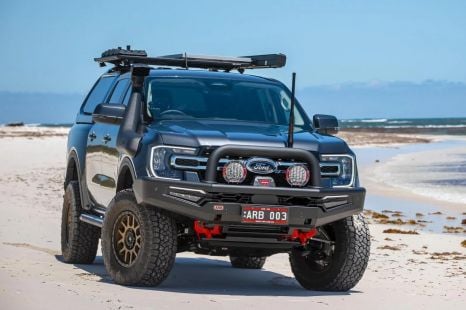

William Stopford
12 Days Ago